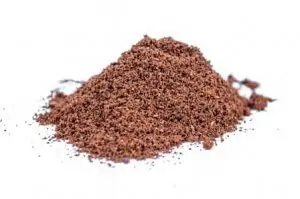Coffee is one of the most widely consumed beverages in the US and around the world.
According to recent studies, the average American drinks a little over 2 cups of coffee a day!
OK, I’ll admit, I have more than 2 cups of java a day!
Most people don’t know that their steaming, aromatic cup of daily life elixir started as a small, red fruit – known as a coffee cherry – picked by hand from slender, leafy bushes.

See the Cuisinart Supreme Grind Automatic Burr Mill at Amazon.
Whether it’s a simple espresso shot, a frothy cappuccino, the interesting new nitro-cold brew, or a basic dose of instant coffee for desperate times, the process from cherry to bean to the liquid you consume remains fairly consistent.
| Best Coffee Grinder for Coarse Grinds | Why We Like It |
|---|---|
| 1. Cuisinart DBM-8 Supreme Grind Automatic Burr Mill | holds an amazing 32 cups of coffee |
| 2. KONA Manual Coffee Grinder | is smaller and portable |
| 3. Capresso 560.01 Infinity Conical Burr | has 16 different grind settings |
Coffee-Making: Behind the Scenes
The coffee cherries are usually hand-picked from the coffee bushes, selected for their ripeness, signaled by a deep red color.
From berry to bean…to your morning cup of Joe. That’s how it goes.
They are then either selected and sorted by hand and laid out to dry, or, in the more common industrial process, are put through a de-pulping process.
This is when the skin and pulp is stripped by a pulping machine, leaving just the bean.
The beans are then funneled through water canals where they are sorted, with lighter beans floating to the top and heavier ones sinking to the bottom.
The sorted beans are then kept in a water fermentation tank for anywhere from 12 to 48 hours of time, depending on their weight and type. Afterward, they are laid out to dry.
After drying, the beans, still inside the rough coating called the parchment envelope, are then put through a hulling machine which removes the parchment coating.
The “green coffee,” as it’s called at this point, is then sorted and selected for size and weight, and placed in containers ready to be shipped out to roasting plants.
The roasting process releases the oil inside the beans, turning them into the brown, fragrant pebbles familiar to most consumers.
And from here, finally, we arrive at the process that most coffee consumers have some experience with…
Grinding the roasted beans (and enjoying the resulting beverage, of course)!
History of the Coffee Grinder
The first coffee grinder was the stone and pestle, used in Ethiopia in 800 A.D. to pulverize coffee beans into powder that was then consumed in liquid or solid forms.
Coffee was used for everything from daily use to religious practices and ceremonies. From there, millstones were used to grind beans in Arabia in the 11th century.
The Romans devised their own system for grinding based on the technology of wheat mills, and in 15th century Turkey and Persia, manually-operated, ornately decorated spice grinders ground coffee beans directly into an attached dish.
Though when you think about England you’re probably more likely to think about tea than coffee – but here’s a surprise…
It was, in fact, a Londoner – one Nicholas Book – who in 1665 claimed the title of being the first person to sell a mill designed for the sole purpose of grinding coffee.
It was around this time that coffee grinders began to be used commercially throughout Europe in coffeehouses and cafes.
In the US the first patent for a coffee grinder was given out in 1798 (to Thomas Jefferson’s dentist, it so happens – so much for coffee being bad for your teeth!).
From there, more coffee grinders were produced and eventually packaged ground coffee began to be sold and consumed regularly.
Nowadays there is a myriad of models of coffee grinders available and accessibly priced which let you make your own coffee at home, directly from the roasted beans.
Why Grind Your Own Coffee?
Besides the earthy, natural feeling that comes from participating in the coffee production process a little bit closer to when it could technically be called a “fruit”.
Grinding your own coffee is a great way to experiment with taste, consistency, flavoring, and strength in your cup of Joe.
And it saves you a few dollars compared to shelling out five bucks for that latte every morning. Plus, you have more control over the grind size, ranging from fine, to medium, to coarse.
Why Does the Grind Size Matter?
It’s important that the grind size of your coffee complements your brewing method. For a coarse grind, the natural brewing method is the French Press.
The French Press brewing method calls for the coarsely ground coffee to be steeped in a beaker with hot water for approximately two to four minutes, after which the grounds are separated from the now-liquid coffee via a manually operated plunger.
The resulting coffee is more flavorful than when a filter is used, as the ground particles steep for longer and are still present in the final product.
The Best Grinders for Coarse Grinds
Are you tempted to get your own grinder for French Press and other coarse grinds, just imagining the aroma wafting through your kitchen in the morning?
I know I am! Here are a few models for coarse grinds that will have you sipping your French Press coffee in no time.
Cuisinart DBM-8 Supreme Grind Automatic Burr Mill
The Cuisinart DBM-8 Supreme Grind Automatic Burr Mill has the power and capacity to keep you grinding and drinking coffee for days.
The removable grind chamber hosts a whopping 32 cups of coffee. And there’s no guessing on your part since it has an electric timer will automatically shut off the grinding process when complete.
KONA Manual Coffee Grinder
In need of something smaller and more portable to make great coffee on the go? The KONA Manual Coffee Grinder is a perfect choice if you want a small, efficient grinder that will fit in your backpack.
Yes, it’s perfect while out hiking mountain trails, or, perhaps, in your tiny desk cubicle as you stare blankly at your computer screen.
Its high wear material and easy clean, durable jar lets you grind beans for up to 2 cups of coffee.
Keep in mind that it’s manual, so you’ll be doing more than pushing a button. And you’ll have to gauge when the grind is coarse enough.
Capresso 560.01 Infinity Conical Burr
If you’re not completely sold on only drinking coffee made from coarse grind, the Capresso 560.01 Infinity Conical Burr is the way to go.
With 16 different grind settings, the Capresso 560.01 Infinity Conical Burr has you covered from coarse grinds for French Press to the finest grinds for espresso.
Get your morning fix with a straight up shot of Espresso! Check out these recommendations for the best Espresso Makers.
Grind, Steep, Sip – repeat!
I could follow these steps every day, all day!
Now that you’ve seen a few of the best coffee grinders for coarse grind, you can pick the best one to suit your needs.





